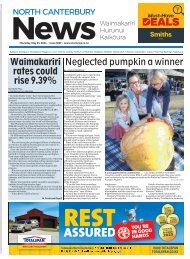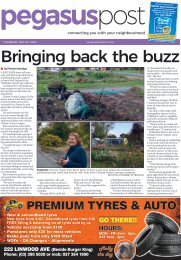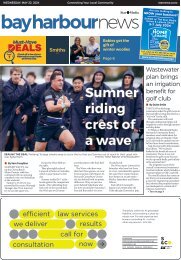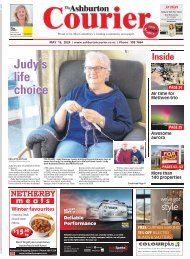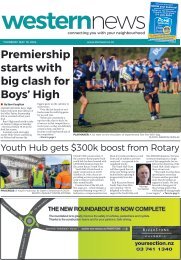Style: May 20, 2020
Create successful ePaper yourself
Turn your PDF publications into a flip-book with our unique Google optimized e-Paper software.
14 STYLE | report<br />
Lucy took time to learn the<br />
art of cheesemaking while<br />
the facility was built. Photo:<br />
John Doogan Photography.<br />
The milk produced by the Italian water buffalo is turned into<br />
cheese. Photos: John Doogan Photography.<br />
THE CHEESEMAKER<br />
Out in the Malvern Hills is a herd of Italian water buffalo, producing milk that is turned<br />
into mouth-watering cheeses. Wairiri Buffalo’s Lucy Appleton tells her story.<br />
My favourite buffalo is Daisy; she is named after my<br />
grandmother. She was abandoned by her mum – she<br />
didn’t seem to want to have anything to do with her, so I was<br />
like, ‘Right, this is an opportunity to hand-raise a buffalo.’ We<br />
have 50 and all of them have names and are full of character.<br />
We chose Italian water buffalo for our farm because we<br />
wanted something that would not only produce a good<br />
return, but be good for our soft land with high rainfall. Buffalo<br />
have a very wide cloven hoof and they seemed to be very<br />
suitable, so that is what we did. We have 100 acres and half<br />
is covenanted forest and swampland, so hopefully, we will be<br />
carbon neutral or negative. The idea is to have less impact on<br />
the planet.<br />
It took about four years to build the facility because we<br />
did most of it ourselves. Then, we had to learn everything;<br />
how to milk buffalo; what we needed to milk buffalo; how to<br />
make cheese; risk management and get the building certified.<br />
We went nice and slowly.<br />
While we were building, I needed to go get the knowledge<br />
on how to make cheese. It is a bit like if you imagine<br />
someone who starts up a car garage and they are not a<br />
mechanic; they are probably not that useful. I had to make<br />
sure I had the intellectual knowledge and capacity to design<br />
and operate a cheese factory.<br />
So, I started with a goat and learned to make the basic,<br />
easy cheeses. I did a cheese course and learned a lot from<br />
my brother-in-law, he’s a microbiologist, and my friend is a<br />
chemist. Then, I visited two cheese factories in Italy.<br />
Initially, I thought I would only do mozzarella, but then I<br />
realised the milk is incredible for all other cheeses. Like a<br />
camembert is phenomenal; any cheese made out of this<br />
milk is phenomenal. It is high-end A2 milk, so a lot of people<br />
who can’t have A1 milk can have the buffalo milk. Using it in<br />
coffee is incredible too. The milk has a silky, light palate, so it<br />
is a great base for coffee.<br />
Quite a few Indian people also use the milk to make their<br />
own fresh paneer. I was at a market a while ago and this<br />
Indian guy was selling vegetables and I had leftover products.<br />
I said to him, ‘Here, have this.’ He looked at me and said, ‘Is<br />
that buffalo milk?’ and I said, ‘Yes.’ His mouth dropped open<br />
because he hadn’t had it since he was a child in India! I had<br />
six leftover bottles, so I just went and gave him the whole lot<br />
and he was stunned.<br />
You can have a lot of fun with Italian stretched-curd<br />
cheeses, because what happens, from a scientific point of<br />
view, is really quite entertaining.<br />
You can create all sorts of things. With caciocavallo,<br />
because it is huge, we need four hands to create it. It is quite<br />
interesting working with two sets of hands. There is a real<br />
science behind making cheese.<br />
Support Lucy at wairiribuffalo.nz




